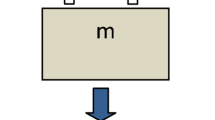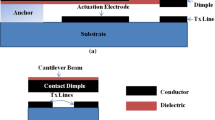Abstract
In this paper, we have designed and analyzed the performance of reconfigurable antennas for wireless communication applications using RF MEMS switches over the frequency range of 0.5–7.5 GHz. The proposed reconfigurable antenna is designed with three identical shunt capacitive RF MEMS switches with AlN as a dielectric material. The RF MEMS switch used for the design of reconfigurable microstrip patch antenna is offering good performance i.e., actuation voltage is 4.5 V, the switching time is 45 µs. Based on the switching of the RF MEMS switches, the antenna is resonating at 0.9, 1.5, 3.5, 5.4 GHz. So, the antenna designed is capable to serve in multiple applications like RFID, GPS, WiMAX, and WLAN.
Access provided by Autonomous University of Puebla. Download conference paper PDF
Similar content being viewed by others
Keywords
- Electrostatic actuation
- Material analysis
- Reconfigurable antenna
- RF MEMS switches
- Wireless communication
1 Introduction
The demand for innovative wireless communication applications is drastically increasing day by day [1, 2]. To fulfill this demand, there is a necessity for novel and optimized communication devices like reconfigurable antennas, phase shifters, and RF isolators with low power consumption. Especially in 5G technology, there is a significant demand for reconfigurable antennas with multi-operating frequencies and low interferences [3, 4]. The researchers are investigated with intense curiosity to propose the optimized solution and to design a reconfigurable antenna with best performance. In this era, MEMS technology is shown great potential in the design of communication devices with low power consumption and high linearity.
This is the major motivated factor to design reconfigurable antennas by using RF MEMS switches other than traditional solid-state electronic switches (PIN diode and FET transistor) [5,6,7]. MEMS technology has recently received significant attention due to its ability to enhance the performance of RF switches. Despite the best performance, decreasing the pull-in voltage, increasing the reliability, and improving the switching time are significant research challenges in RF MEMS switches. Improving the capacitance ratio and achieving the best RF performance are the potential challenges in capacitive RF MEMS switches [8,9,10]. RF MEMS switch-based reconfigurable antennas are offering the best performance when compared with structure-based reconfigurable antennas [11,12,13].
In this paper, we have presented an investigation and design analysis on the performance of reconfigurable antennas using shunt capacitive RF MEMS switches. These configurations aim to provide the following bands: GPS bands (1.2–1.6 GHz), WLAN bands (2.39–2.4 and 5.2–5.6 GHz), RFID (0.9–5.2 GHz), some satellite bands (3.7–4.2, 5.1–6.25, and 6.7–7.1 GHz), and GSM bands (1.85–1.9 GHz) (Table 1).
2 Reconfigurable Antenna
In this paper, we have designed a reconfigurable microstrip patch antenna using shunt capacitive RF MEMS switches. The antenna is aimed to serve multiple applications like RFID, WLAN, GPS, and WiMAX applications.
2.1 RF MEMS Switches
The shunt capacitive RF MEMS switches are used as the basic switching elements used for making the antenna as reconfigurable. The switch is designed with serpentine structure membrane of gold (Au) material of 1 µm thickness (Table 2; Figs. 1, 2 and 3).
The membrane is perforated with 5 µm × 5 µm size square shape holes. Electrostatic actuation is used to deform the membrane. The RF MEMS switch designed using COMSOL tool is offering good performance i.e., the required actuation voltage is 4.5 V, the switching time of the switch is 45 µs. We have done a wide range of analyses on the serpentine membrane in terms of max/min actuation voltages points, max/min displacement points, isolating surface for electric potential, displacement direction, and contour for electric potential, principal stress points.
2.2 Reconfigurable Antenna Using RF MEMS Switches
The reconfigurable microstrip patch antenna is designed by placing three identical shunt capacitive RF MEMS switches i.e., S1, S2, and S3 (Fig. 4).
All three switches are individually connected to biasing pads. Silicon is used as a substrate. Silicon dioxide is used as an insulating material on the top of the silicon substrate (Figs. 5 and 6).
CPW type feeding is used with G/S/G value 50 µm/100 µm/50 µm. The structure of the reconfigurable antenna is designed by connecting the four patches i.e., P1, P2, P3, and P4. The P1 patch is conned with P2, P3, and P4 through three switches S1, S2, and S3, respectively. If S1-OFF, S2-OFF, and S3-OFF, the antenna is resonating at 5.4 GHz. If S1-OFF, S2-OFF, and S3-ON, the antenna is resonating at 0.9 GHz. If S1-OFF, S2-ON, and S3-ON, the antenna is resonating at 1.5 GHz. If S1-OFF, S2-ON, and S3-ON, the antenna is resonating at 3.5 and 8.4 GHz. Based on the switching of the RF MEMS switches, the antenna is resonating at 0.9, 1.5, 3.5, and 5.4 GHz. So, the proposed antenna is suitable for multiple applications like RFID, GPS, WiMAX, and WLAN (Table 3).
3 Conclusion
The demand for the reconfigurable antenna is increasing day by day. In this paper, we have designed a reconfigurable microstrip patch antenna for low-frequency communication applications using shunt capacitive RF MEMS switches. The RF MEMS switch used is offering high performance. The reconfigurable antenna is designed with three RF MEMS switches. Based on the switching of the RF MEMS switches, the antenna is resonating at 0.9, 1.5, 3.5, 5.4 GHz. So, the designed antenna is suitable for multiple applications like RFID, GPS, WiMAX, and WLAN.
References
Ramana, R., Shanmugananthamb, T., Sindhanaiselvic, D.: Analysis of RF MEMS series switch with serpentine spring shaped cantilever beam for wireless applications. Mater. Today: Proc. 5, 1890–1896 (2018)
Shekhar, S., Vinoy, K.J., Anantha Suresh, G.K.: Surface-micromachined capacitive RF switches with low actuation voltage and steady contact. J. Microelectromech. Syst. (2017). https://doi.org/10.1109/jmems.2017.2688519
Mulloni, V., Margesin, B., Farinelli, P., Marcelli, R., Lucibello, A., De Angelis, G.: Cycling reliability of RF–MEMS switches with Gold-Platinum multilayers as contact material. Microsyst. Technol. (2015). https://doi.org/10.1007/s00542-015-2782-2
Shah, I.A., Hayat, S., Basir, A., Zada, M., Shah, S.A.A., Ullah, S., Ullah, S.: Design and analysis of a hexa-band frequency reconfigurable antenna for wireless communication. Int. J. Electron. Commun. (2018). https://doi.org/10.1016/j.aeue.2018.10.012
Kang, H.Y., Hu, H.Y., Han, B.G., Su, H.: A reconfigurable solid-state plasma dipole antenna based on SPiN diodes. Microelectron. Eng. 214, 55–59 (2019). https://doi.org/10.1016/j.mee.2019.04.025
Abou Al-Alaa, M., Elsadek, H.A., Abdallah, E.A.: Compact multi-band frequency reconfigurable planar monopole antenna for several wireless communication applications. J. Electr. Syst. Inf. Technol. 1, 17–25 (2014). http://dx.doi.org/10.1016/j.jesit.2014.03.008
Cetiner, B.A., Jafarkhani, H., Qian, J.-Y., Yoo, H.J., Grau, A., De Flaviis, F.: Multifunctional reconfigurable MEMS integrated antennas for adaptive MIMO systems. Adaptive antennas and MIMO systems for wireless systems. IEEE Commun. Mag. (2004)
Deng, Z., Hong, M., Yao, Y.: Ka-band reconfigurable microstrip patch antenna with switchable pattern. Integr. Ferroelectr.: Int. J. 128(1), 49–53 (2011). https://doi.org/10.1080/10584587.2011.576186
Gil, I., Morata, M., Fernández, R., Rottenberg, X., De Raedt, W.: Characterization and modelling of switchable stop-band filters based on RF-MEMS and complementary split ring resonators. Microelectron. Eng. 88, 1–5 (2011)
Haridas, N., Erdogan, A.T., Arslan, T., Walton, A.J., Smith, S., Stevenson, T., Dunare, C., Gundlach, A., Terry, J., Argyrakis, P., Tierney, K., Ross, A., O’Hara, T.: Reconfigurable MEMS antennas. In: NASA/ESA Conference on Adaptive Hardware and Systems, pp. 147–154. IEEE Computer Society (2008). https://doi.org/10.1109/ahs.2008.28
Kim, I., Rahmat-Samii, Y.: RF MEMS switchable slot patch antenna integrated with bias network. IEEE Trans. Antennas Propag. 59(12) (2011)
Rebeiz, G.M., Muldavin, J.B.: RF MEMS switches and switch circuits. IEEE Microw. Mag. (2001)
Angira, M., Bansal, D., Kumar, P., Mehta, K., Rangra, K.: A novel capacitive RF-MEMS switch for multi-frequency operation. Superlattices Microstruct. 133 (2019)
Sharma,· U., Kumar, M., Sharma, R., Saha, T., Jain, K.K., Dutta, S., Sharma, E.K.: Fabrication process induced changes in scattering parameters of meander type RFMEMS shunt switch. Microsyst. Technol. (2017). https://doi.org/10.1007/s00542-017-3314-z
Guha, K., Laskar, N.M., Gogoi, H.J., Borah, A.K., Baishnab, K.L., Baishya, S.: Novel analytical model for optimizing the pull-in voltage in a flexured MEMS switch incorporating beam perforation effect. Solid-State Electron. 137, 85–94 (2017)
Thalluri, L.N., Guha, K., Srinivasa Rao, K., Venkata Hari Prasad, G., Girija Sravani, K., Sastry, K.S.R., Kanakala, A.R., Bose Babu, P.: Perforated serpentine membrane with AlN as dielectric material shunt capacitive RF MEMS switch fabrication and characterization. Microsyst. Technol. (2020). https://doi.org/10.1007/s00542-020-04755
Author information
Authors and Affiliations
Editor information
Editors and Affiliations
Rights and permissions
Copyright information
© 2021 The Author(s), under exclusive license to Springer Nature Singapore Pte Ltd.
About this paper
Cite this paper
Thalluri, L.N. et al. (2021). Reconfigurable Antennas for RFID/GPS/WiMAX/WLAN Applications Using RF MEMS Switches. In: Biswas, A., Saxena, R., De, D. (eds) Microelectronics, Circuits and Systems. Lecture Notes in Electrical Engineering, vol 755. Springer, Singapore. https://doi.org/10.1007/978-981-16-1570-2_21
Download citation
DOI: https://doi.org/10.1007/978-981-16-1570-2_21
Published:
Publisher Name: Springer, Singapore
Print ISBN: 978-981-16-1569-6
Online ISBN: 978-981-16-1570-2
eBook Packages: EngineeringEngineering (R0)










